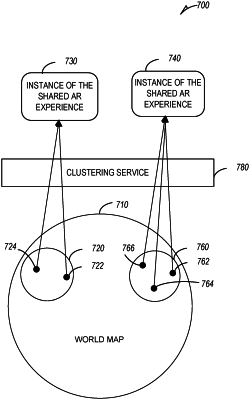| CPC G06F 3/1454 (2013.01) [A63F 13/87 (2014.09); G06F 3/011 (2013.01); A63F 2300/8082 (2013.01)] | 18 Claims |

|
1. A method comprising:
in a messaging system that hosts a backend service for a messaging client and that provides a shared AR experience, receiving a request to launch the shared AR experience at a first user device located at a first geographic location, the shared AR experience associated with a virtual object and an activity UI generated for respective participating devices using respective camera views of the respective participating devices, a camera view of a device with respect to an instance of the shared AR experience comprising an output of a digital image sensor of a camera of the device;
determining a first AR experience area corresponding to the first geographic location, wherein the first AR experience area enables multiple users that are within an area defined by three latitude/longitude pairs that encompass the first geographic location to simultaneously interact with the virtual object;
communicating to the first user device a first address identifying the first user device as a participating device with respect to a first instance of the shared AR experience;
causing display of the activity UI on a display of the first user device;
identifying a location of a second user device based on GPS information from the second user device;
determining that the location of the second user device is within a predefined distance from the first AR experience area and that the location of the second user device is outside of the area defined by the three latitude/longitude pairs;
generating user interface data to display directions on the second user device toward the first AR experience area;
determining that the location of the second user device is within of the area defined by the three latitude/longitude pairs; and
causing display of the activity UI on a display of the second user device.
|